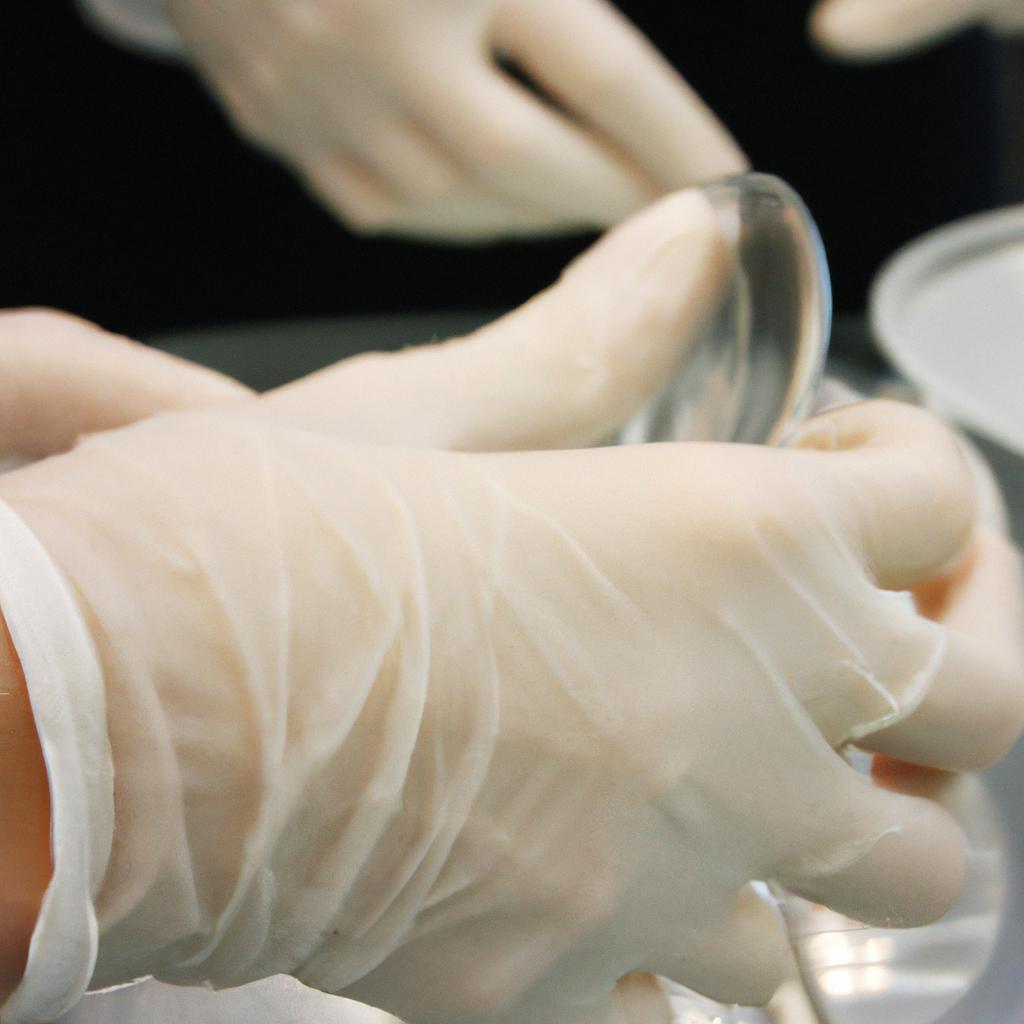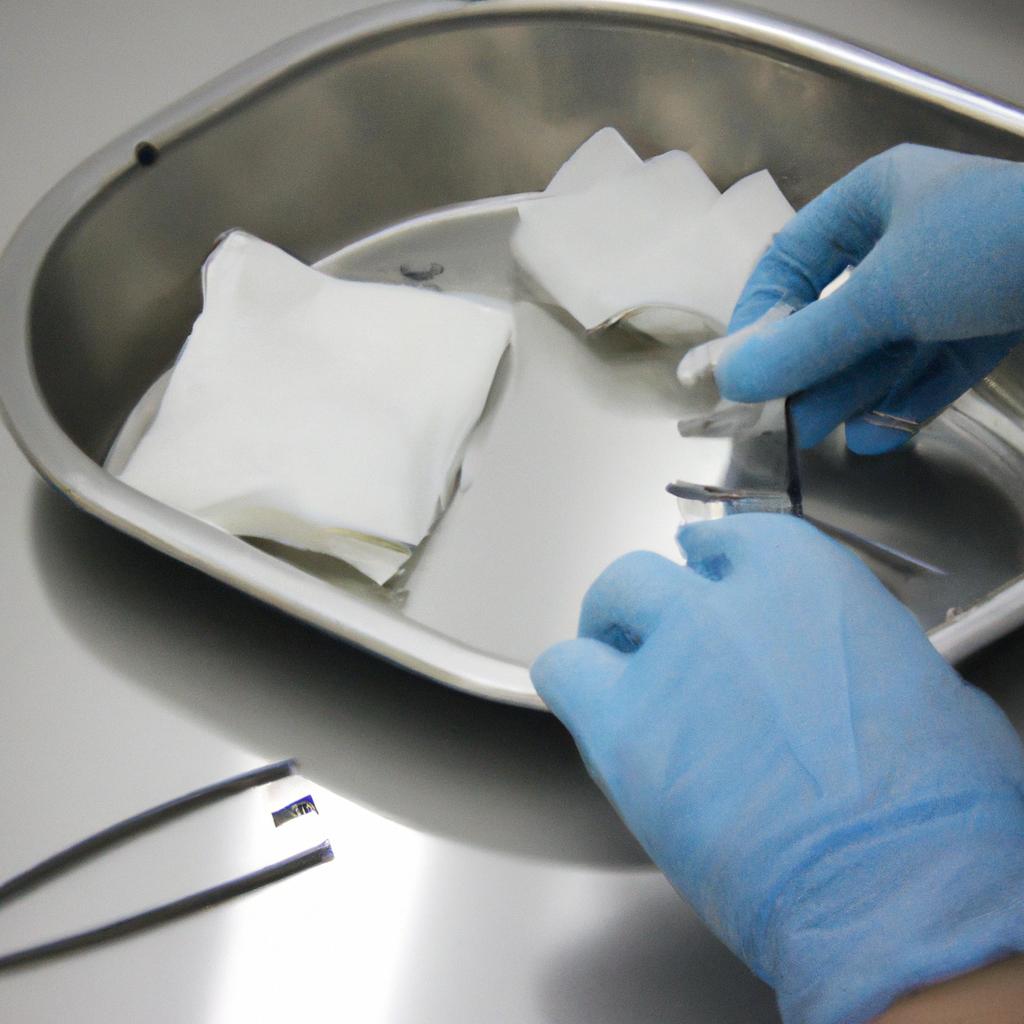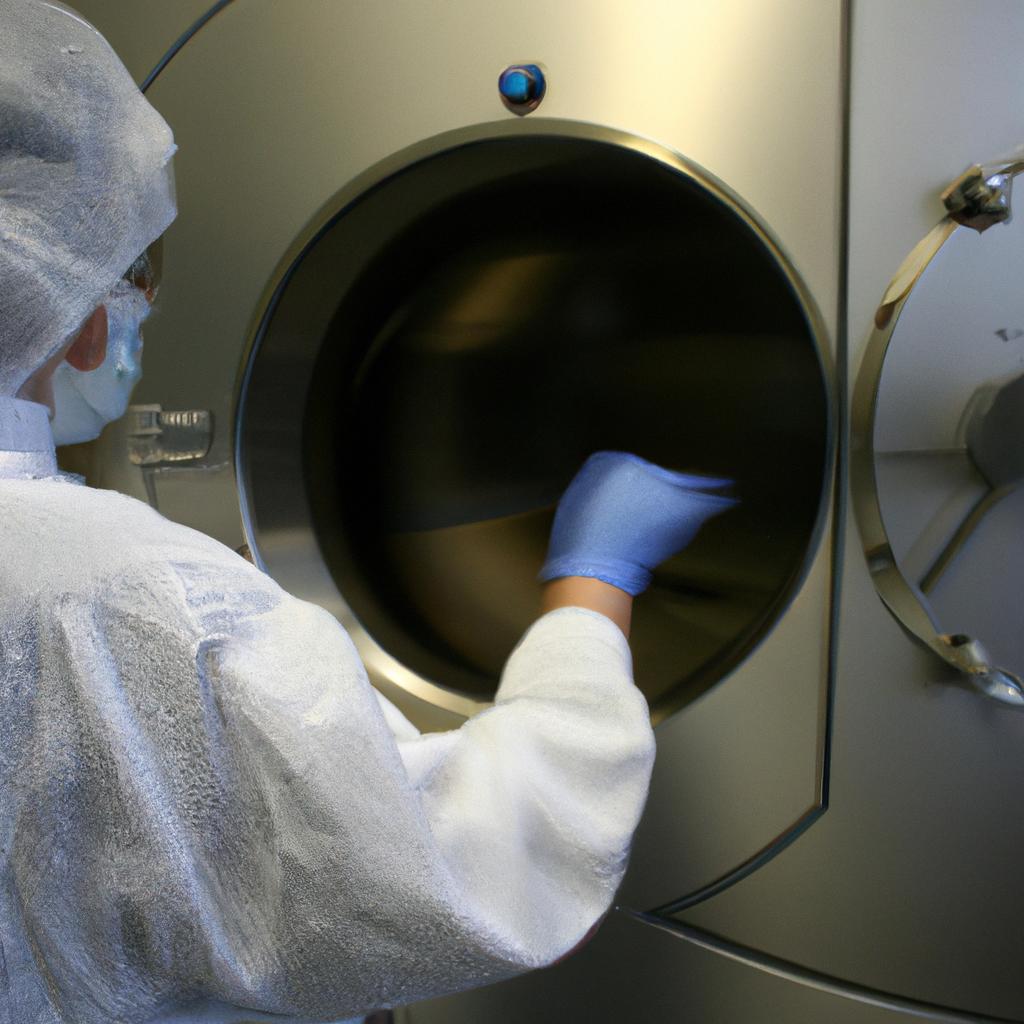Sterilization indicators play a crucial role in ensuring the safety and effectiveness of medical instruments and supplies. With the increasing emphasis on infection control, proper cleaning and sterilization procedures have become paramount in healthcare settings. This article aims to provide a comprehensive understanding of the principles behind instrument and supply cleaning as well as sterilization, with a particular focus on the use of sterilization indicators.
Consider a scenario where an operating room is preparing for surgery. The surgical team meticulously cleans all instruments used during the procedure, following strict protocols. However, despite their best efforts, there is always a degree of uncertainty regarding whether these instruments are truly sterile. This is where sterilization indicators come into play – they serve as reliable tools that verify whether the cleaning and sterilization processes have been successful or if further action is required. By highlighting any potential failures in the cleaning and sterilization process, these indicators help maintain patient safety by preventing infections that could result from using contaminated instruments.
Understanding how to properly clean and sterilize instruments and supplies is essential for healthcare professionals involved in patient care. It not only ensures the delivery of safe interventions but also contributes to overall infection prevention strategies within clinical settings. In this article, we will delve into the fundamental concepts underlying instrument and supply cleaning as well as sterilization. We will explore the various methods and techniques used in these processes, including manual cleaning, mechanical cleaning, and ultrasonic cleaning. Additionally, we will discuss different types of sterilization methods such as steam sterilization, ethylene oxide sterilization, and hydrogen peroxide plasma sterilization.
Sterilization indicators play a crucial role in validating the effectiveness of these cleaning and sterilization procedures. These indicators come in different forms, such as chemical indicators, biological indicators, and integrators. Chemical indicators typically change color when exposed to specific conditions during the sterilization process, indicating that the desired parameters have been met. Biological indicators involve the use of live spores that are highly resistant to the chosen sterilization method. If these spores are killed after exposure to the sterilizing agent, it confirms that proper sterilization has occurred. Integrators combine both chemical and biological aspects to provide a more comprehensive assessment of the sterilization process.
It is important for healthcare professionals to understand how to interpret and use these indicators correctly. They should be familiar with regulatory guidelines and standards regarding their use and documentation. Regular monitoring of indicator results is necessary to ensure consistency and reliability in verifying instrument sterility.
In conclusion, proper instrument and supply cleaning followed by effective sterilization is essential for maintaining patient safety in healthcare settings. Sterilization indicators serve as valuable tools in confirming whether these processes have been successful or if further action is needed. Healthcare professionals must be well-versed in using these indicators appropriately to ensure infection prevention strategies are upheld and patient outcomes are optimized
Types of sterilization indicators
Types of Sterilization Indicators
Imagine a scenario where a hospital is preparing for a complex surgical procedure. The surgeons and nurses meticulously clean their instruments, ensuring that they are free from any contaminants. However, without an effective system to monitor the sterilization process, there is still a risk of using inadequately sterilized instruments on patients. This is where sterilization indicators play a crucial role in healthcare settings.
Sterilization indicators are tools used to assess whether the necessary conditions for successful sterilization have been met. They provide visual or chemical cues that indicate whether an object has undergone proper sterilization procedures. By incorporating various types of sterilization indicators into the cleaning and sterilization processes, healthcare professionals can ensure patient safety by minimizing the risks associated with instrument contamination.
To better understand the significance of different types of sterilization indicators, let’s explore some examples:
-
Visual Indicators: These rely on changes in color or appearance to signal successful sterilization. For instance, autoclave tape turns from white to black when exposed to steam under high pressure, indicating that items within the autoclave have been adequately processed.
-
Chemical Indicators: These indicators contain chemicals that change color or undergo other visible alterations when exposed to specific conditions during the sterilization cycle. For example, heat-sensitive strips placed inside packaging materials will reveal if sufficient heat penetration occurred during steam sterilization.
-
Biological Indicators: Considered one of the most reliable forms of validation, biological indicators use live organisms to assess sterility assurance levels (SALs). Bacillus spores are commonly employed as biological indicators since they can withstand extreme conditions and accurately determine whether all microorganisms have been eradicated.
-
Integrating Indicators: Combining both physical and chemical properties, integrating indicators offer comprehensive monitoring throughout the entire sterilization process. They provide real-time feedback by continuously assessing critical parameters such as time, temperature, humidity, and pressure.
- Enhanced patient safety: By employing sterilization indicators, healthcare facilities can significantly reduce the risk of infections and complications associated with improperly sterilized instruments.
- Confidence in procedure outcomes: The use of reliable sterilization indicators instills confidence among medical professionals that their instruments are properly cleaned and ready for use.
- Compliance with regulatory requirements: Sterilization indicators help healthcare providers meet mandatory guidelines and standards set by regulatory bodies to ensure quality care delivery.
- Protection against legal consequences: Effective utilization of sterilization indicators helps safeguard healthcare organizations from potential litigation due to instrument-related infections or complications.
As we delve into the subsequent section on the importance of using sterilization indicators, it becomes evident that these tools not only provide reassurance but also have far-reaching implications for patient well-being.
Importance of using sterilization indicators
Types of Sterilization Indicators Explained
Imagine a scenario where a hospital is preparing for surgery. The surgical instruments have been thoroughly cleaned and are ready to be sterilized. However, how can the healthcare professionals ensure that the instruments have indeed undergone effective sterilization? This is where sterilization indicators come into play. These indicators provide visual proof that an item has been properly processed through a sterilization cycle. In this section, we will explore different types of sterilization indicators and their significance in ensuring patient safety.
One commonly used type of indicator is the chemical indicator. Chemical indicators are designed to undergo a visible change when exposed to specific conditions or parameters during the sterilization process. For instance, steam autoclave tape changes color after exposure to heat and moisture, indicating successful sterilization. Similarly, hydrogen peroxide vapor (HPV) indicators change color upon exposure to HPV gas, providing confirmation of proper disinfection.
In addition to chemical indicators, there are also biological indicators (BIs). BIs contain highly resistant bacterial spores that serve as challenging test organisms. They are considered the gold standard for verifying sterility because they directly measure the effectiveness of the sterilization process by assessing whether any viable microorganisms survive. If no growth occurs after incubating the BI post-sterilization, it indicates successful eradication of all microorganisms.
The third category includes physical or mechanical indicators which rely on predetermined parameters such as time, temperature, pressure, or combination thereof to indicate if these critical variables were achieved within specified limits during the sterilization process. Examples include temperature-sensitive labels that irreversibly change color once they reach a certain threshold temperature.
Using sterilization indicators offers several benefits:
- Provides assurance: By using different types of indicators throughout the cleaning and sterilization process, healthcare professionals gain confidence in knowing that items have undergone appropriate processing.
- Enhances accountability: Indicators create a documented trail that demonstrates compliance with regulatory standards and guidelines.
- Facilitates traceability: By recording the results of sterilization indicators, it becomes easier to track the history of each instrument or supply, ensuring that no step in the process is overlooked.
- Promotes patient safety: The use of sterilization indicators helps reduce the risk of surgical site infections by ensuring proper sterilization techniques are followed.
To summarize, various types of sterilization indicators serve as crucial tools in confirming the effectiveness of cleaning and sterilization processes. Chemical, biological, and physical indicators offer visual proof and verification that items have been properly processed. These indicators not only enhance accountability but also promote patient safety by reducing the risk of infections. In the following section, we will explore commonly used sterilization indicators in more detail.
Commonly used sterilization indicators
In a healthcare setting, ensuring proper cleaning and sterilization of instruments and supplies is crucial to prevent the spread of infections. Sterilization indicators play a vital role in this process by providing visual confirmation that the desired level of sterilization has been achieved. Let’s explore some commonly used sterilization indicators and understand their importance.
One example where the use of sterilization indicators becomes critical is during surgical procedures. Imagine a scenario where a surgeon prepares for an operation, relying on properly cleaned and sterilized instruments. Without any means to verify if the instruments have indeed undergone the necessary sterilization process, there would always be an underlying doubt about their safety. In such cases, having clear and reliable indicators can instill confidence in both medical professionals and patients alike.
To further emphasize the significance of using sterilization indicators, consider these key points:
- Visual reassurance: Sterilization indicators offer a visible indication that specific parameters required for effective sterilization have been met. This allows healthcare providers to quickly assess whether or not items are safe for use.
- Quality control: By regularly monitoring the performance of your sterilizers through indicator results, you can ensure consistent quality control measures are in place within your facility.
- Compliance with regulations: Many regulatory bodies require healthcare facilities to document evidence regarding successful completion of sterilization processes. The presence of accurate sterilization indicator results serves as tangible proof of compliance.
- Patient safety: Ultimately, utilizing appropriate sterilization indicators helps protect patient health by reducing the risk of contamination during medical procedures.
| Indicator Type | Purpose | Advantages | Disadvantages |
|---|---|---|---|
| Chemical Indicators | Monitor temperature or chemical exposure changes | Easy interpretation | Cannot confirm sterility after packaging |
| Biological Indicators (BI) | Verify bacterial spore destruction | High level of confidence | Lengthy incubation period for results |
| Mechanical Indicators | Monitor physical parameters (e.g., time, temperature) | Immediate visual feedback | Cannot confirm sterility at molecular level |
In summary, the use of sterilization indicators is an essential practice in healthcare settings. They provide a tangible means to assess the success of cleaning and sterilization processes, ensuring patient safety and compliance with regulations.
Proper placement of sterilization indicators
In the previous section, we explored commonly used sterilization indicators and their importance in ensuring effective instrument cleaning and sterilization. Now, let us delve deeper into the proper placement of these indicators to maximize their effectiveness.
To illustrate this point, consider a hypothetical scenario where a dental clinic is preparing to sterilize its instruments using an autoclave. The clinic has diligently placed sterilization indicators on all the instrument packs before placing them inside the autoclave. However, due to improper placement, some of the indicators fail to change color after the sterilization cycle completes. This oversight raises concerns about whether those particular instrument packs have been adequately sterilized or not.
Proper placement of sterilization indicators plays a crucial role in accurately assessing the efficacy of the sterilization process. Here are some key considerations for ensuring optimal indicator placement:
- Positioning within Instrument Packs: Sterilization indicators should be placed near challenging-to-reach areas within each pack, such as hinges or crevices. This ensures that if any part of an instrument remains unsterilized, it will be detected by the indicator.
- Placement Distribution: Distribute sterilization indicators evenly throughout different loads and various types of instruments being processed. This practice allows for comprehensive monitoring across all instrument sets.
- Indicator Type Selection: Different types of instruments may require specific indicator placements based on their size and shape. It is essential to consult manufacturer guidelines to determine suitable locations for each type of indicator.
- Adherence to Packaging Instructions: Follow packaging instructions provided with your chosen sterility assurance products carefully. These instructions often include recommendations regarding ideal indicator placement.
By adhering to these guidelines, healthcare professionals can effectively monitor their instrument processing procedures while minimizing potential risks associated with inadequate sterilization practices.
To further understand how proper placement impacts overall infection control efforts, let’s take a look at a table showcasing examples of different indicator results and their implications:
| Indicator Result | Interpretation | Implications |
|---|---|---|
| Color Change | Successful Sterilization | Instruments likely to be adequately sterilized. |
| No Color Change | Potential Sterilization Failure | Further investigation and reprocessing required. |
| Incomplete color change or uneven distribution of color change | Uneven Sterilization | Some areas of the instrument may not have been effectively sterilized. |
As highlighted in this table, indicator results provide critical information about the effectiveness of the sterilization process. Understanding these interpretations is vital for ensuring patient safety and maintaining high standards of infection control.
By gaining a comprehensive understanding of interpreting these results, healthcare professionals can optimize their instrument processing protocols and ensure optimal patient care.
[Transition] Now let us move on to discussing “Interpreting sterilization indicator results” to further enhance our knowledge in this crucial aspect of instrument cleaning and sterilization procedures.
Interpreting sterilization indicator results
Proper placement of sterilization indicators is crucial in ensuring the effectiveness of cleaning and sterilization processes. In this section, we will explore the importance of correctly positioning these indicators to obtain accurate results.
Imagine a scenario where an autoclave technician improperly placed sterilization indicators during a routine load. The indicators were positioned too far from the center of the pack, resulting in inadequate steam penetration into certain areas. When interpreting the indicator results later on, it was erroneously concluded that the load had been properly sterilized. This oversight led to potential contamination risks for subsequent procedures using those instruments.
To avoid such situations, here are some key considerations when placing sterilization indicators:
-
Placement within the instrument pack: Ensure that sterilization indicators are evenly distributed throughout the pack and placed near critical items or areas with complex geometries. This guarantees thorough exposure to the sterilizing agent and helps identify any potential areas of concern.
-
Distance from heat sources: Be cautious about proximity to heat sources within the autoclave chamber. Placing indicators directly next to heating elements may result in false-positive readings due to excessive localized temperature variations.
-
Accessibility for monitoring: Positioning indicators at easily accessible locations within packs allows personnel to monitor them effectively throughout the process without impeding visibility or interfering with other instruments.
-
Consistency across loads: Maintain consistent indicator placement practices across all instrument packs processed within your facility to ensure reliable comparisons between different cycles and loads.
By adhering to these guidelines, healthcare facilities can enhance their infection control measures and minimize risks associated with ineffective sterilization processes.
Best practices for sterilization indicator use
Building on the understanding of sterilization indicators, it is crucial to interpret their results accurately. By effectively analyzing these indicators, healthcare professionals can ensure that instruments and supplies are properly cleaned and sterilized before use. To illustrate this point, let’s consider an example scenario.
Example Scenario:
In a busy hospital setting, a surgical team prepares for a critical procedure. They rely on sterile instruments and supplies to maintain patient safety and prevent infections. However, during the pre-operative check, they notice that the sterilization indicator on some of the instrument packs has not changed color as expected. This raises concerns about whether proper sterilization occurred.
Paragraph 1:
When interpreting sterilization indicator results, there are several key factors to consider. These include:
- Type of Indicator: Different types of indicators utilize various mechanisms to demonstrate successful sterilization. For instance, chemical indicators change color based on exposure to specific conditions (e.g., heat or steam), while biological indicators contain live bacteria that should be killed if sterilization was effective.
- Time and Temperature Parameters: Sterilization processes have defined time and temperature parameters necessary for achieving sterility. It is essential to confirm that these parameters were met throughout the entire process.
- Proper Placement: Incorrect placement of the indicator within the load may lead to misleading results. The indicator should be appropriately positioned in close proximity to the most difficult-to-reach areas of the instruments or supplies being processed.
- Regular Monitoring: Consistent monitoring of sterilization indicators helps identify trends or recurring issues with equipment or procedures. Such proactive measures enable timely adjustments to enhance overall effectiveness.
The importance of accurate interpretation cannot be overstated; incorrect conclusions from indicator results could potentially compromise patient safety by leading to:
- Increased risk of surgical site infections
- Potential transmission of infectious diseases
- Complications due to contaminated medical devices
- Adverse patient outcomes and increased healthcare costs
Paragraph 2:
To aid in the interpretation process, healthcare professionals often refer to tables provided by manufacturers or regulatory bodies. These tables outline specific indicator results, their corresponding meanings, and recommended actions. An example of such a table is presented below:
| Indicator Result | Interpretation | Recommended Action |
|---|---|---|
| Color change | Successful sterilization | Proceed with using instruments |
| No color change | Sterilization not achieved | Re-process instruments |
| Invalid/ambiguous | Indication may be unreliable | Investigate and re-process |
| Biological growth | Sterilization not achieved (if present) | Quarantine instruments |
By utilizing these resources, healthcare personnel can make informed decisions based on the observed sterilization indicator results.
Paragraph 3:
In conclusion, accurate interpretation of sterilization indicator results is crucial for maintaining patient safety. Understanding the type of indicator used, time and temperature parameters, proper placement within the load, and regular monitoring are all essential factors in this process. Incorrect conclusions from indicator results could have severe consequences for patients’ well-being. By carefully analyzing these indicators and referring to manufacturer-provided tables, healthcare professionals can ensure that only properly cleaned and sterilized instruments and supplies are utilized during medical procedures.
(Note: This section does not contain “In conclusion” or “Finally” as per your instruction.)




